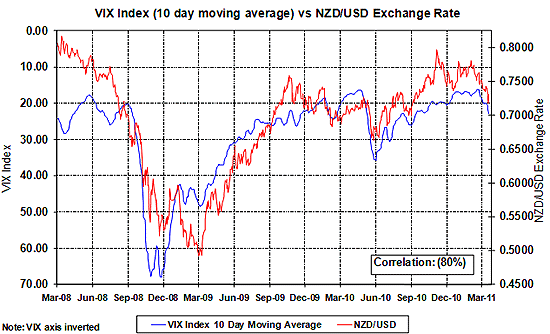

By Roger J Kerr
Last week we all witnessed the susceptibility and vulnerability of a currency like the NZ dollar, which is everybody’s favourite when the tide is coming in (Asia up, global growth up, commodities up) however it is the first in line to sell when the tide is going out.
The dramatic strengthening of the Japanese Yen following the earthquake, as Japanese investment houses brought funds home, caused a break of the key level of 80.00 against the USD, in turn triggering massive stop-loss buying of Yen, selling of NZD’s and AUD’s as retail and wholesale speculative currency positions were forced to be closed-out on margin calls.
The speed and quantum of the Yen buying/NZD and AUD selling last Thursday morning took the markets completely by surprise and the Kiwi plunged well below supposed support levels.
Yet again, it was a lesson to international investors and traders in the NZ dollar market that as a small currency we are easy to buy progressively over time, however when special events cause a stampede for the exit door, those NZD currency market doors are very narrow indeed in terms of daily market liquidity to absorb the surge in volumes required.
The dive in the NZD from 0.7300 to lows of 0.7120 last week did provide hedging opportunities for USD exporters, particularly those who had been hedging to policy minimums with options whilst the Kiwi was above 0.7500 for most of the last several months.
... Yen panic attack prompts first joint central bank currency market intervention in 10 years
The Japanese Government and Bank of Japan called on their mates in the G7 nations to join with them in intervening directly in currency markets to sell the Yen on Friday.
Intervention was always highly likely after the Yen broke below 80.00 and for a short period looked like heading to 75. Quite typical of the Yen currency, it does not move out of a two or three Yen trading band for 18-24 months, then suddenly appreciates five Yen in 24 hours.
The joint G7 central bank selling of Yen against the USD was seemingly successful initially, the Yen returning right back up to 82.00 from lows of 77.00.
Unfortunately, the selling of the Yen could not be sustained in the markets as the USD weakened generally against the Pound and Euro in Friday night trading.
The return of the Yen to just under 81.00 has allowed the Kiwi and Aussie dollars to bounce right back up to where they originally came from (NZD at 0.7300 and the AUD at $1.0000).
The problem with the Yen is that there are just no regular sellers of the currency.
The big Japanese investment funds and companies are not investing outside Japan these days and their importers sold their Yen (bought USD’s) forward some time ago.
It is estimated that Japanese exporters are profitable again at a JPY/USD rate of 86.00.
The question for the global FX markets this week is whether that joint currency market intervention continues now that the Yen has weakened to above 80.00. The market conditions would be more conducive for Yen weakness/USD strength if the Euro was weakening against the USD, not strengthening as it currently is.
... EUR/USD view 100% wrong so far, but give it time
The strength of the Euro to $1.4200 is hard to fathom in the face of continually improving US economic data.
Contrary to my expectations, the market’s anticipation of increases in European interest rates later this year is dominating over US economic data and causing the USD to weaken in a period when I predicted the opposite to occur.
The European Central Bank’s fears about rising food and energy prices causing inflation above what they are comfortable with seems to me to be way overdone.
The Federal Reserve operates differently, looking through short-term spikes in food and energy prices to the underlying core inflationary pressures.
I question whether the ECB will deliver to the current European interest rate market pricing of three official rate increases later this year. Despite the "stringent" and tough-talking words from Mr Trichet of the ECB, in the end I don’t think they will deliver on the rhetoric; that is, hold back from increasing Euro interest rates.
Local exporters in Euro and GBP need to take advantage of the current strength in these two currencies and hedge forward, particularly to protect 2012 receipts when the NZD may be appreciating on its own account due to rising NZ interest rates i.e. EUR and GBP cross-rate higher.
... post natural disasters, the Kiwi set to return to following market volatility, the AUD and commodity prices
The Kiwi has depreciated from 07800 to 0.7100 due to the two natural disaster events of the last month, not due to the USD strengthening in international currency markets as we thought would be the cause.
However from here, in the absence of local economic surprises, the drivers of the Kiwi dollar direction must return to USD and AUD movements globally.
With Japan disrupted and questions over Chinese demand due to their tightening of monetary policy, the commodity price increases look far less assured.
The AUD will weaken and the USD will strengthen on further retreats in global commodity prices.
The investors and speculators in commodity markets have just experienced a sharp lesson in what goes up in a straight line is always going to be vulnerable to a major correction down. All that is needed is a catalyst to spark the profit-taking.
The Japanese earthquake could be that catalyst that reminds commodity buyers that ever increasing Asian demand is not a given.
Global equity and commodity markets are displaying increased volatility as an uncertain world of natural disasters, a Middle-East powder-keg and over-hyped commodity prices erode investor confidence. The Kiwi dollar always goes down when investor risk is being taken off the table and market volatility increases, as it is right now (see chart below, the blue VIX volatility index inverted on the left-hand axis).
Thursday’s GDP figures for the December quarter do not seem that important against the natural disasters and the subsequent economic and FX market reactions.
A positive +0.20% to +0.40% increase for the quarter with dairy, manufacturing and forestry industries rebounding on their output should silence the double-dip recession advocates. The result is a bit academic now, however a +0.40% outcome might stimulate NZD buying.
A surprise negative outcome would cause more NZD selling.
There is a wide range of forecasts due to a good whack of the supporting economic data (manufacturing, wholesale trade) being delayed over this last month due to Statistics NZ being located in Christchurch.

--------------------
* Roger J Kerr runs Asia Pacific Risk Management. He specialises in fixed interest securities and is a commentator on economics and markets. More commentary and useful information on fixed interest investing can be found at rogeradvice.com
No chart with that title exists.

We welcome your comments below. If you are not already registered, please register to comment
Remember we welcome robust, respectful and insightful debate. We don't welcome abusive or defamatory comments and will de-register those repeatedly making such comments. Our current comment policy is here.